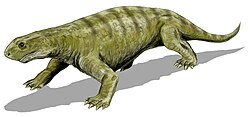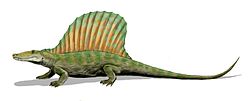| Eosyodon Temporal range: | |
|---|---|
| Scientific classification | |
| Domain: | Eukaryota |
| Kingdom: | Animalia |
| Phylum: | Chordata |
| Clade: | Synapsida |
| Family: | † Sphenacodontidae |
| Genus: | † Eosyodon Olson, 1962 |
| Species: | †E. hudsoni |
| Binomial name | |
| †Eosyodon hudsoni Olson, 1962 | |
Eosyodon is a dubious genus of extinct non-mammalian synapsids from the Permian of Texas. Its type and only species is Eosyodon hudsoni. Though it was originally interpreted as an early therapsid, it is probably a member of Sphenacodontidae, the family of synapsids that includes Dimetrodon .
Contents
Eosyodon hudsoni was named by Everett C. Olson in 1962 on the basis of fragmentary material from the San Angelo Formation in Texas. [1] The species name honors J. Hudson, a ranch foreman who aided Olson's work. A femur, currently cataloged as FMNH UR 575, was designated the holotype, and skull fragments, partial ribs, and a few other bones were also assigned to the species. Olson interpreted Eosyodon as a therapsid closely related to Syodon , and assigned both genera to the family Brithopodidae of the infraorder Eotheriodontia. Eotheriodonta was a new taxon defined by Olson in the same paper, to encompass several taxa he regarded as a group of therapsids intermediate between pelycosaurs and later therapsids. [2]
In 1995, C. A. Sidor and J. A. Hopson presented a reevaluation of Olson's eotheriodonts at the annual conference of the Society of Vertebrate Paleontology, and concluded that they were based on caseid and sphenacodontid pelycosaurs. [3] In 2011, Christian Kammerer agreed with their evaluation and concluded that Eosyodon was a sphenacodontid. [4] He regarded Eosyodon as a nomen dubium.
Olson regarded the San Angelo fauna, including Eosyodon, as being from the early Guadalupian, chronologically equivalent to the Kazanian therapsid fauna of Russia. [5] However, the San Angelo Formation is now regarded as belonging to the Kungurian stage of the Permian. [6] [7] As such, Eosyodon is somewhat older than the earliest definitive therapsids.





